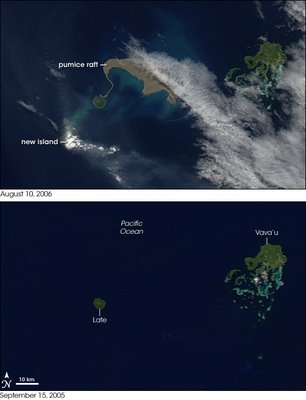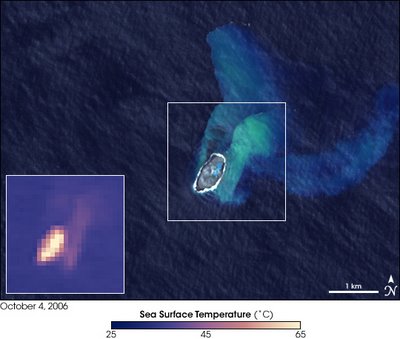Thanks to sNIPEOUT for drawing our attention to some superb photos from NASA of the new island and the pumice raft.

The NASA website earth observatory has the story...
The Moderate Resolution Imaging Spectroradiometer (MODIS) flying onboard NASA'’s Aqua satellite captured the aftermath of the eruption on August 10, 2006 (top), at 1:30 UTC (2:30 p.m. local time). For comparison, the bottom image shows the same area on September 15, 2005.The earth observatory site also has more recent photos of the new island...In the top image, the emerging volcanic island is partially hidden by its own plume. Volcanic plumes often appear drab gray or beige compared to clouds, and plumes from the emerging island move away from it in different directions, one to the southeast, and some to the north. The bright white spot directly over the island may be cloud cover, or it could be steam resulting from volcanic emissions.
The raft of pumice appears to the northeast of the emerging island, and it actually connects, via a thin thread, to neighboring Late Island. The blue-green color of the water around the raft and the new island is probably fine sediment that is making the deep blue water more reflective.

On October 4, 2006, the Advanced Spaceborne Thermal Emission and Reflection Radiometer (ASTER) on NASA'’s Terra satellite observed the newly emerged Home Reef. This image shows two views of the volcano. The larger image uses a combination of light visible to human eyes and infrared light. In this picture, dark blue indicates relatively clear water, light blue-green indicates water mixed with sediment, and the white ring around the island shows rocky material. The inset image shows temperatures on and around the island, with bright yellow being the warmest and dark purple being the coolest.Hmmm - that sounds interesting - lakes with water at 150 degrees Fahrenheit. If I can find a way to ship my Laser there maybe I could make the Guinness Book Of Records for hottest lake ever sailed?Both images indicate a warm plume from the island that moves in a northeasterly direction before splitting in two. The exact origin of this plume is uncertain. It could result from underwater volcanic activity, but it might also result from solar heating of pumice remaining in the area. The island itself sports volcanic lakes, some as warm as 64.7 degrees Celsius (almost 150 degrees Fahrenheit).
1 comment:
Just don't capsize in that lake...or you'll be pretty well done...
Post a Comment